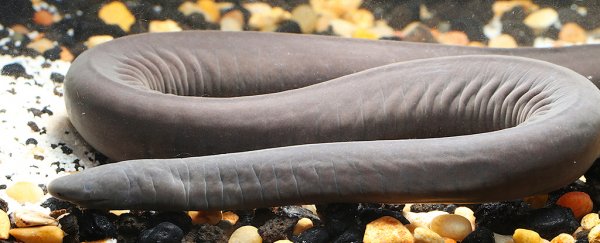The strange-looking caecilians are limbless, worm-like amphibians that have been around for hundreds of millions of years, but they've never been found in the wild in the US – until now.
It's now been confirmed that a creature caught in 2019 in the C-4 (or Tamiami) Canal in Florida is a Rio Cauca caecilian, Typhlonectes natans. The species is native to Colombia and Venezuela, and can grow more than half a meter (20 inches) in length.
The captured amphibian recently died and was passed on to experts at the University of Florida, where an examination and DNA analysis revealed that this was indeed a caecilian.
"Very little is known about these animals in the wild, but there's nothing particularly dangerous about them, and they don't appear to be serious predators," says herpetologist Coleman Sheehy from the University of Florida.
"They'll probably eat small animals and get eaten by larger ones. This could be just another non-native species in the South Florida mix."
What experts do know about caecilians is that they often spend a lot of time underground or in freshwater. With some species reaching sizes of up to 5 feet (152 centimeters), they might seem like formidable hunters. But they also happen to have very poor eyesight, hence the name – 'caecilians' translates to 'blind ones' in Latin.
It was recently discovered that caecilians have snake-like venom glands – the only amphibians to have them – and they could in fact be the oldest animal around in evolutionary terms with a venomous bite.
Since the first 2019 sighting, more reports of caecilian-like creatures have come in from South Florida. Field work in the canal is planned to figure out how widespread these species might be in the waters.
"At this point, we really don't know enough to say whether caecilians are established in the C-4 Canal," says Sheehy. "That's what we want to find out."
The conditions would be right for the animals though: back home, the Typhlonectes natans species lives amongst aquatic vegetation in bodies of shallow water that are warm and slow-moving, just like the C-4 Canal.
Technically speaking, the animals have been to the US before, but not recently: 170 million year-old fossilized remains have been found in the American Southwest, but until the new discovery, no surviving descendants had been found anywhere north of Mexico.
As for how caecilians made it to Florida, that's another unanswered question – but given Typhlonectes natans is the most common type in the pet trade and can breed in captivity, Sheehy thinks the newly identified specimen could be a pet someone didn't want.
"This was not on my radar," says Sheehy. "I didn't think we'd one day find a caecilian in Florida. So, this was a huge surprise."
The research has been published in Reptiles & Amphibians.
